Abstract
The fossils species †Fundulus detillae, †F. lariversi, and †F. nevadensis from localities in the western United States are represented by well-preserved material with date estimations. We combined morphological data for these fossil taxa with morphological and DNA-sequence data to conduct a phylogenetic analysis and a tip-based divergence-time estimation for the family Fundulidae. The resultant phylogeny is largely concordant with the prior total-evidence phylogeny. The fossil species do not form a monophyletic group, and do not represent a discrete western radiation of Fundulus as previously proposed. The genus Fundulus diverged into subgeneric clades likely in the Eocene or Oligocene (mean age 34.6 mya, 53–23 mya), and all subgeneric and most species-group clades had evolved by the middle Miocene. †Fundulus lariversi is a member of subgenus Fundulus in which all extant species are found only in eastern North America, demonstrating that fundulids had a complicated biogeographic history. We confirmed †Fundulus detillae as a member of the subgenus Plancterus. †F. nevadensis is not classified in a subgenus but likely is related to the subgenera Plancterus and Wileyichthys.
References
Abers, J.P. & Stewart, J.H. (1972) Geology and mineral deposits of Esmeralda County, Nevada. Nevada Bureau of Mines and Geology Bulletin, 78, 1–80.
Bell, M.A. (1977) A Late Miocene marine threespine stickleback, Gasterosteus aculeatus aculeatus, and its zoogeographic and evolutionary significance. Copeia, 1977, 277–282.
https://doi.org/10.2307/1443909Bell, M.A. (1994) Paleobiology and evolution of threespine stickleback. In: Bell, M.A. & Foster, S.A. (Eds.), The Evolutionary Biology of the Threespine Stickleback. Oxford University Press, Oxford, pp. 428–471.
Davis, M.P., Arratia, G.A. & Kaiser, T. (2013) The first fossil shellear and its implications for the evolution and divergence of the Kneriidae (Teleostei: Gonorynchiformes). In: Arratia, G.A., Schultze, H.P. & Wilson, M.V.H. (Eds.), Mesozoic Fishes V. Verlag Dr. F. Pfeil, München, pp. 325–362.
Davis, M.P., Sparks, J.S. & Smith, W.L. (2016) Repeated and Widespread Evolution of Bioluminescence in Marine Fishes. PLOS ONE, 11 (6), e0155154.
https://doi.org/10.1371/journal.pone.0155154Drummond, A. & Rambaut, A. (2007) BEAST: Bayesian evolutionary analysis by sampling trees. BMC Evolutionary Biology, 7, 214.
https://doi.org/10.1186/1471-2148-7-214Eastman, C.R. (1917) Fossil fishes of the collection of the United States National Museum. Proceedings of the United States National Museum, 52, 235–304.
https://doi.org/10.5479/si.00963801.52-2177.235Felsenstein, J. (1985) Confidence limits on phylogenies: An approach using a bootstrap. Evolution, 39, 783–791.
https://doi.org/10.2307/2408678Ghedotti, M.J. & Davis, M.P. (2013) Phylogeny, classification, and evolution of salinity tolerance of the North American topminnows and killifishes, Family Fundulidae (Teleostei: Cyprinodontiformes). Fieldiana, Life and Earth Sciences, 7, 1–65.
https://doi.org/10.3158/2158-5520-12.7.1Ghedotti, M.J., Simons, A.M. & Davis, M.P. (2004) Morphology and phylogeny of the studfish clade, subgenus Xenisma (Teleostei, Cyprinodontiformes). Copeia, 2004, 53–61.
https://doi.org/10.1643/CI-02-184R2Heath, T.A., Huelsenbeck, J.T. & Stadler, T. (2014) The fossilized birth-death process for coherent calibration of divergence-time estimates. Proceedings of the National Academy of Sciences USA, 111, 2957–2966. [E2957–E2966]
https://doi.org/10.1073/pnas.1319091111Helmsttetter, A.J., Oaoadopulos, A.S.T., Igea, J., Van Dooren, T.J.M., Leroi, A.M. & Savolainen, V. (2016) Viviparity stimulates diversification in an order of fish. Nature Communications, 7, 11271.
https://doi.org/10.1038/ncomms11271Hertwig, S.T. (2008) Phylogeny of the Cyprinodontiformes (Teleostei, Atherinomorpha): The contribution of cranial soft tissue characters. Zoologica Scripta, 37, 141–174.
https://doi.org/10.1111/j.1463-6409.2007.00314.xHibbard, C.W. & Dunkle, D.H. (1942) A new species of cyprinodontid fish from the Pliocene of Kansas. Kansas Geological Survey Bulletin, 41, 270–276.
Hrbek, T. & Meyer, A. (2003) Closing of the Tethys Sea and the phylogeny of Eurasian killifishes (Cyprinodontiformes: Cyprinodontidae). Journal of Evolutionary Biology, 16, 17–36.
https://doi.org/10.1046/j.1420-9101.2003.00475.xKsepka, D.T., Balanoff, A.M., Bell, M.A. & Houseman, M.D. (2013) Fossil grebes from the Truckee Formation (Miocene) of Nevada and a new phylogenetic analysis of Podicipediformes (Aves). Paleontology, 56, 1149–1169.
https://doi.org/10.1111/pala.12040Katoh, K., Misawa, K., Kuma, K. & Miyata, T. (2002) MAFFT: A novel method for rapid multiple sequence alignment based on the fast Fourier transformation. Nucleic Acids Research, 30, 3059–3066.
https://doi.org/10.1093/nar/gkf436Lewis, P.O. (2001) A likelihood approach to estimating phylogeny with discrete morphological character data. Systematic Biology, 50, 913–925.
https://doi.org/10.1080/106351501753462876Lugaski, T. (1977) Fundulus lariversi, a new Miocene fossil cyprinodont fish from Nevada. The Wassmann Journal of Biology, 35, 203–211.
McMahan, C.D., Chakrabarty, P., Sparks, J.S., Smith, W.L. & Davis, M.P. (2013) Temporal Patterns of Diversification across Global Cichlid Biodiversity (Acanthomorpha:Cichlidae). PLoS ONE, 8 (8), e71162.
https://doi.org/10.1371/journal.pone.0071162Miller, R.R. (1945) Four new species of fossil cyprinodont fishes from eastern California. Journal of the Washington Academy of Science, 35, 315–321.
Near, T.J., Eytan, R.I., Dornburg, A., Kuhn, K.L., Moore, J.A., Davis, M.P., Wainwright, P.C., Friedman, M. & Smith, W.L. (2012) Resolution of ray-finned fish phylogeny and timing of diversification. Proceedings of the National Academy of Sciences, 109 (34), 13698–13703.
https://doi.org/10.1073/pnas.1206625109Posada, D. (2008) jModeltest: Phylogenetic model averaging. Molecular Biology and Evolution, 25, 1253–1256.
https://doi.org/10.1093/molbev/msn083Robertson, G.M. (1943) Fundulus sternbergi, a Pliocene fish from Kansas. Journal of Paleontology, 17, 305–306.
Silbermann, M.L. & McKee, E.H. (1972) A summary of radiometric age determination of Tertiary volcanic rocks from Nevada and eastern California, Part II – western Nevada. Isochron/West, 4, 7–28.
Smith, C.L. (1962) Some Pliocene fishes from Kansas, Oklahoma, and Nebraska. Copeia, 1962, 505–520.
https://doi.org/10.2307/1441172Smith, G.R., Dowling, T., Gobalet, K.W., Lugaski, T., Shiazawa, D. & Evans, R.P. (2002) Biogeography and timing of evolutionary events among Great Basin fishes. In: Hershler, R., Madsen, D.B. & Currey, D.R. (Eds.), Great Basin Aquatic Systems History. Smithsoniam Contributions to Earth Sciences, 33, 175–234.
Smith, W.L., Chakrabarty, P. & Sparks, J.S. (2008) Phylogeny, taxonomy, and evolution of neotropical cichlids (Teleostei: Cichlidae: Cichlinae). Cladistics, 24, 625–641.
https://doi.org/10.1111/j.1096-0031.2008.00210.xStadler, T. (2010) Sampling-through-time in birth-death trees. Journal of Theoretical Biology, 267, 396–404.
https://doi.org/10.1016/j.jtbi.2010.09.010Whitehead, A. (2010) The evolutionary radiation of diverse osmotolerant physiologies in killifish (Fundulus spp.). Evolution, 64, 2070–2085.
Zwickl, D.J. (2006) Genetic algorithm approaches for the phylogenetic analysis of large biological sequence datasets under the maximum likelihood criterion. Unpublished Ph.D. thesis, University of Texas, Austin, 115 pp.

